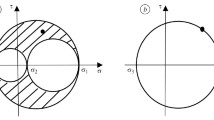A survey of the multiaxial fatigue criteria including the ratio of normal and shear stresses is presented. We also discuss the fatigue characteristics of some selected structural materials in bending and torsion. The ratio of normal stresses to shear stresses is determined for a given number of cycles N f within the range 5∙104 −2∙106 . Moreover, it follows from the performed analysis of the fatigue equations and the relative difference R that the materials can be split into groups for which it is possible or impossible to apply a constant value of the considered ratio in the criteria including this ratio.








Similar content being viewed by others
References
ASTM E 739-91 (1998): Standard Practice for Statistical Analysis of Linearized Stress–Life (s − N) and Strain-Life (ε − N) Fatigue Data, Annual Book of ASTM Standards, Vol. 03.01, Philadelphia (1999), pp. 614–620.
O. I. Balyts’kyi, L. M. Ivas’kevych, V. M. Mochul’s’kyi, and O. M. Holiyan, “Influence of hydrogen on the crack resistance of 10Kh15N27T3V2MR steel,” Mater. Sci., No. 2, 258–267 (2009).
A. Carpinteri and A. Spagnoli, “Multiaxial high-cycle fatigue criterion for hard metals,” Int. J. Fatigue, 23, 135–145 (2001).
A. Esderts, Betriebsfestigkeit bei mehrachsiger Biege und Torsionsbeanspruchung, Fakultat für Berbau, Huttenwesen und Maschinenwesen der Technischen Universitat Clausthal, June 9 (1995).
T. Fakuda and H. Nisitani, Background of Fatigue Limit Ratio of Torsional Fatigue to Rotating Bending Fatigue in Isotropic Materials and Materials with Clear-Banded Structure, Department of Mechanical Engineering, Sasebo National College of Technology, Japan, Sasebo (1993).
W. N. Findley, “A theory for the effect of mean stress on fatigue of metals under combined torsion and axial load or bending,” J. Eng. Industry, 301–306 (1959).
H. J. Gough, Some Experiments on the Resistance of Metals to Fatigue under Combined Stresses, His Majesty’s Stationery Office, London (1951).
D. Kardas, K. Kluger, T. Łagoda, P. Ogonowski, “Trwałość zmęczeniowa duraluminium PA6 w warunkach proporcjonalnego stało amplitudowego zginania ze skręcaniem,” in: XX Symp. Zmęczenie i Mechanika Pękania, Bydgoszcz–Pieczyska, ATR Bydgoszcz (2004), S. 163–169.
T. Kohut and M., Łagoda, “Badania zmęczeniowe mosiądzu MO58 w warunkach proporcjonalnego cyklicznego zginania ze skręcaniem,” in: III Symp. Mechaniki Zniszczenia Materiałów i Konstrukcji, Augustów, June 1–4, Politechnika Białostocka (2005), pp. 159–162.
S. B. Lee, “A criterion for fully reversed out-of-phase torsion and bending,” in: Multiaxial Fatigue ASTM STP 853, Philadelphia (1985), pp. 553–568.
T. Łagoda and P. Ogonowski, “Criteria of multiaxial random fatigue based on stress, strain, and energy parameters of damage in the critical plane,” Mat.-Wiss. Werkstofftech, 36, No. 9, 429–437 (2005).
D. L. McDiarmid, “Fatigue under out-of-phase bending and torsion,” Fatigue Fract. Eng. Mater. Struct., 9, No. 6, 457–475 (1987).
F. Morel, Fatigue Multiaxiale Sous Chargement D’Amplitude Variable, Docteur De L’Universite de Poitiers, Futuruscope (1996).
A. Muller, Zum Festigkeitsverhalten von Mehrachsig Stochastisch Beanspruchten Guβeisen mit Kugelgraphit und Temperguβ, Fraunhofer, Institut für Betriebsfestigkeit, Darmstadt (1994).
A. Niesłony and C. M. Sonsino, Comparison of Some Selected Multiaxial Fatigue Assessment Criteria, Fraunhofer Institut für Betriebsfestigkeit Systemzuverlassigkeit (2008).
T. Nishihara and M. Kawamoto, “The strength of metals under combined alternating bending and torsion with phase difference,” in: Memoirs of the College of Engineering, 11, Kyoto Imperial University (1945), pp. 85–112.
R. Pawliczek, Badanie Wpływu Parametrów Obciążenia i Geometrii Karbu na Trwałość Przy Zmiennym Zginaniu i Skręcaniu, Rozprawa Doktorska, Politechnika Opolska, Opole: (2001).
A. Seweryn, Kumulacja Uszkodzeń i Pękanie Elementów Konstrukcyjnych w Złożonych Stanach Obciążeń, Wydawnictwo Politechniki Białostockiej, Białystok (1997).
Z. Skrzyszowski, Reduktor Stożkowo-Walcowy, Wydawnictwa Politechniki Krakowskiej (2000).
M. Kurek, T. Łagoda, and S. Staniczek, “Porównanie charakterystyk zmęczeniowych na zginanie i skręcanie wybranych materiałów konstrukcyjnych. Zmęczenie i Mechanika Pękania,” in: J. Sempruch and D. Skibicki (editors), Materiały XXIII Symp. Zmęczenia i Mechaniki Pękania, Wydawnictwo Uczelniane Uniwersytetu Technologiczno-Przyrodniczego, Bydgoszcz (2010), pp. 81–82 CD; pp. 267–276.
K. Walat and T. Łagoda, “The equivalent stress on the critical plane determined by the maximum covariance of normal and shear stresses,” Met.-Wiss. Werkstofftech, 41, No. 4, 218–220 (2010).
H. Zenner and J. Liu, “The fatigue limit under multiaxial loading,” in: Proc. of the Sixth Internat. Conf. on Biaxial/Multiaxial Fatigue & Fracture, Vol. 1, Lisboa (2001), pp. 29–39.
Author information
Authors and Affiliations
Corresponding author
Additional information
Published in Fizyko-Khimichna Mekhanika Materialiv, Vol. 47, No. 3, pp. 59–67, May–June, 2011.
Rights and permissions
About this article
Cite this article
Kurek, M., Łagoda, T. Comparison of the fatigue characteristics for some selected structural materials under bending and torsion. Mater Sci 47, 334–344 (2011). https://doi.org/10.1007/s11003-011-9401-x
Received:
Published:
Issue Date:
DOI: https://doi.org/10.1007/s11003-011-9401-x




